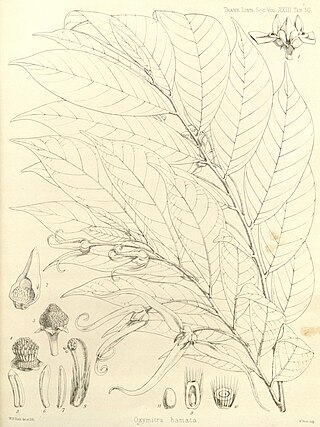
Neostenanthera hamata is a species of plant in the family Annonaceae. It is found in Ivory Coast, Ghana, Liberia, and Sierra Leone. George Bentham, the English botanist who first formally described the species, using the basionym Oxymitra hamata, did not explicitly explain the specific epithet, but it has distinctive outer petals with hooked tips.
Pseudoxandra williamsii is a species of plant in the Annonaceae family. It is endemic to Peru. Robert Elias Fries, the Swedish botanist who first formally described the species using the basionym Cremastosperma williamsii, named it after Llewelyn W. Williams, the Welsh economic botanist, who collected the holotype specimen he examined.
Annona stenophylla is a species of plant in the family Annonaceae. It is native to Tanzania and Zambia. Adolf Engler and Ludwig Diels, the German botanists who first formally described the species, named it after its narrow leaves.

Cremastosperma cauliflorum is a species of plant in the family Annonaceae. It is native to Brazil, Colombia, Ecuador and Peru. Robert Elias Fries, the Swedish botanist who first formally described the species, named it after its flowers which grow from its main trunk or stem.
Fusaea decurrens is a species of plant in the family Annonaceae. It is native to Peru. Robert Elias Fries. The Swedish botanist who first formally described the species, named it after wings of the leaves that run down the stem of the leaf.
Goniothalamus expansus is a species of plant in the family Annonaceae. It is native to Thailand and Vietnam. William Grant Craib, the British botanist who first formally described the species, named it after its expanded stigmas.
Goniothalamus grandiflorus is a species of rainforest tree in the Custard Apple Family Annonaceae. It is native to New Guinea and the Solomon Islands. It was first formally described by Otto Warburg, a German-Jewish botanist, using the basionym Beccariodendron grandiflorum after its big, dark red flowers. These flowers are borne directly on the trunk and major branches (cauliflory), the largest of all cauliflorous flowers.
Goniothalamus maewongensis is a species of plant in the family Annonaceae. It is native to Thailand. Richard M.K. Saunders and Piya Chalermglin, who first formally described the species, named it after the Mae Wong National Park in Thailand where the type specimen was collected.
Goniothalamus nitidus is a species of plant in the family Annonaceae. It is native to Borneo. Elmer Drew Merrill, the American botanist who first formally described the species, named it after its shining leaves.
Goniothalamus puncticulifolius is a species of plant in the family Annonaceae. It is native to Borneo and The Philippines. Elmer Drew Merrill, the American botanist who first formally described the species, named it after its minutely spotted leaves.

Goniothalamus ridleyi is a species of plant in the family Annonaceae. It is native to Borneo, Peninsular Malaysia, Sumatra and Thailand. George King, who first formally described the species, named it after the English botanist Henry Nicholas Ridley who collected the specimen King examined.
Goniothalamus rongklanus is a species of plant in the family Annonaceae. It is native to Thailand. Richard Saunders and Piya Chalermglin first formally described the species and named it after Phu Hin Rong Kla National Park in Thailand.
Goniothalamus tortilipetalus is a species of plant in the family Annonaceae. It is native to Peninsular Malaysia and Thailand. Murray Ross Henderson, the Scottish botanist who first formally described the species, named it after its twisted petals.
Mitrephora alba is a species of plant in the family Annonaceae. It is native to Peninsular Malaysia. Henry Nicholas Ridley, the English botanist who first formally described the species, named it after its white flowers.

Pseudoxandra lucida is a species of plant in the family Annonaceae. It is native to Bolivia, Brazil, Colombia, Peru, and Venezuela. Robert Elias Fries, the Swedish botanist who first formally described the species, named it after its shiny leaves.

Pseudoxandra polyphleba is a species of plant in the family Annonaceae. It is native to Bolivia, Brazil, Colombia, French Guiana, Guyana, and Peru. Ludwig Diels, the German botanist who first formally described the species using the basionym Unonopsis polyphleba, named it after the distinctive veins in its leaves.
Annona rigida is a species of plant in the family Annonaceae. It is native to Brazil and Colombia. Robert Elias Fries, the Swedish botanist who first formally described the species, named it after its rigid leaves.
Pseuduvaria mollis is a species of plant in the family Annonaceae. It is native to New Guinea. Otto Warburg, the German-Jewish botanists who first formally described the species using the basionym Goniothalamus mollis, named it after the soft hairs on its leaves and petals.

Uvariastrum hexaloboides is a species of plant in the Annonaceae family. It is native to Tanzania, Zambia and Zaire. Robert Elias Fries, the botanist who first formally described the species using the basionym Uvaria hexaloboides, named it after a different species Hexalobus monopetalus which he thought its flowers and vegetative parts resembled.

Xylopia polyantha is a species of plant in the Annonaceae family. It is native to Bolivia, Brazil, Colombia, Ecuador, and Peru. Robert Elias Fries, the botanist who first formally described the species, named it after its many flowers.






